Comparative Analysis of Electrohydraulic and Electromagnetic Sheet Metal Forming against the Background of the Application as an Incremental Processing Technology
Abstract
:1. Introduction
- the local pressure distribution, determined primarily by the shape of the tool coil,
- the course of the current, which depends on the parameters of the electrical circuit, specifically the capacitor charging energy, the capacitance, and the inductance,
- interactions between the workpiece and the die.
- surface condition of the electrodes,
- geometry of the “discharge surfaces” of the electrodes (by means of changes in the discharge surfaces due to the wear on the electrodes),
- local conductivity of the water,
- gas content of the water, and
- presence of particles in the water.
- the pressure generation in the discharge channel
- the vapor-temperature-pressure gradient around the discharge channel
- the compressible liquid as a pressure transmitting medium, and
- the deformation of the chamber and blank in contact with the deformable die.
2. Materials and Methods
2.1. Experimental Setups for Analysis of the EHF and EMF Processes
2.2. Numerical Modeling of the EHF and EMF Processes
3. Results
3.1. Analysis of the Free Forming Process
3.2. Analysis of the Blank Holder Distance
3.3. Analysis of the Pressure Distribution
3.4. Analysis of the Mechanical Support Applied to the Workpiece and the Displacement Boundary Conditions, Respectively
- The limitation of the displacement boundary conditions by means of a blank holder with the ideal distance of for a blank diameter corresponding to the outer radius of the drawing ring of . Section 3.4 explains why this is referred to as the ideal distance.
- The limitation of the displacement boundary conditions by means of a blank holder with the ideal distance for a blank diameter of .
4. Discussion
- Inclusion of the active medium with adequate discretization (e.g., by means of ALE formulation)
- Modeling of the electrical discharge and the plasma channel
- Consideration of the reflection of the pressure wave
- Modeling of the membrane
5. Conclusions
Author Contributions
Funding
Institutional Review Board Statement
Informed Consent Statement
Data Availability Statement
Conflicts of Interest
References
- Lange, K. Umformtechnik Handbuch für Industrie und Wissenschaft. Band 4: Sonderverfahren, Prozeßsimulation, Werkzeugtechnik, Produktion; Springer: Berlin/Heidelberg, Germany, 1993. [Google Scholar]
- Golovashchenko, S. Material formability and coil design in electromagnetic forming. J. Mater. Eng. Perform. 2007, 16, 314–320. [Google Scholar] [CrossRef]
- Balanethiram, V.S.; Xiauyu, H.; Altynova, M.; Daehn, G.S. Hyperplasticity: Enhanced formability at high rates. J. Mater. Process. Technol. 1994, 45, 595–600. [Google Scholar] [CrossRef]
- Psyk, V.; Scheffler, C.; Stalmann, A.; Goede, M. Shaping of Sharp-Edged Design Elements by Electromagnetic Forming. In Forming the Future; Daehn, G., Cao, J., Kinsey, B., Tekkaya, E., Vivek, A., Yoshida, Y., Eds.; The Minerals, Metals & Materials Series; Springer: Cham, Switzerland, 2021; pp. 1315–1327. [Google Scholar] [CrossRef]
- Homberg, W.; Beerwald, C.; Pröbsting, A. Investigation of the Electrohydraulic Forming Process with Respect to the Design of Sharp Edged Contours. In Proceedings of the 4th International Conference on High Speed Forming, Columbus, OH, USA, 9–10 March 2010; Daehn, G., Zhang, Y., Babusci, K., Weddeling, C., Marre, M., Tekkaya, E., Eds.; The Ohio State University: Columbus, OH, USA, 2010. [Google Scholar] [CrossRef]
- Linnemann, M.; Psyk, V.; Djakow, E.; Springer, R.; Homberg, W.; Landgrebe, D. High-Speed Incremental Forming—New Technologies for Flexible Production of Sheet Metal Parts. Procedia Manuf. 2019, 27, 21–26. [Google Scholar] [CrossRef]
- Golovashchenko, S. Electrohydraulic Forming of Near-Net Shape Automotive Panels; Technical Report; U.S. Department of Energy Office of Scientific and Technical Information: Oak Ridge, TN, USA, 2013. [Google Scholar] [CrossRef] [Green Version]
- Yutkin, L.A. Электрoгидравлический Эффект (Electrohydraulic Effect); Mashgiz (State Scientific Technical Press for Machine Construction Literature): Moscow, Russia, 1955. [Google Scholar]
- Chachin, V.N. Electrohydraulic Treatment of Engineering Materials. J. Sci. Technol. 1978, 80–87. [Google Scholar]
- Winkler, R. Hochgeschwindigkeitsbearbeitung: Grundlagen und Technische Anwendung Elektrisch Erzeugter Schockwellen und Impulsmagnetfelder; VEB Verlag: Berlin, Germany, 1973. [Google Scholar]
- Shim, J.Y.; Kang, B.Y. Development of Electrohydraulic Forming Process for Aluminium Sheet with sharp Edge. Adv. Mater. Sci. Eng. 2017, 2017, 2715092. [Google Scholar] [CrossRef] [Green Version]
- Mamutov, A.V.; Golovashchenko, S.F.; Bonnen, J.J.; Gillard, A.J.; Dawson, S.A.; Maison, L. Electrohydraulic Forming of Light Weight Automotive Panels. In Proceedings of the 7th International Conference of High Speed Forming, Dortmund, Germany, 27–28 April 2016. [Google Scholar] [CrossRef]
- Franke, J. Beitrag Zur Fertigung Von Kupferelektroden Durch Funkenentladung Unter Wasser. Ph.D. Thesis, Technische Universität Hannover, Hannover, Germany, 1971. [Google Scholar]
- Eguia, I.; José, J.S.; Knyazev, M.; Zhovnoatyuk, Y. Pressure Field Stabilization in High-Voltage Underwater Pulsed Metal Forming using Wire initiated Discharges. Key Eng. Mater. 2011, 473, 965–972. [Google Scholar] [CrossRef]
- Psyk, V.; Linnemann, M.; Sebastiani, G. Electromagnetic pulse forming. In Mechanics of Materials in Modern Manufacturing Methods and Processing Techniques; Elsevier Series in Mechanics of Advanced Materials; Silberschmidt, V.V., Ed.; Elsevier: Amsterdam, The Netherlands, 2020. [Google Scholar] [CrossRef]
- Bruno, E.J. High-Velocity Forming of Metals; American Society of Tool and Manufacturing Engineers: Deaborn, MI, USA, 1968. [Google Scholar]
- Vivek, A.; Kim, K.H.; Daehn, G.S. Simulation and instrumentation of electromagnetic compression of steel tubes. J. Mater. Process. Technol. 2011, 211, 840–850. [Google Scholar] [CrossRef]
- Qiu, L.; Zhang, W.; Abu-Siada, A.; Liu, G.; Wang, C.; Wang, Y.; Wang, B.; Li, Y.; Yu, Y. Analysis of Electromagnetic Force and Formability of Tube Electromagnetic Bulging Based on Convex Coil. IEEE Access 2020, 8, 33215–33222. [Google Scholar] [CrossRef]
- Gourdin, W.H. Analysis and assessment of electromagnetic ring expansion as a high-strain-rate test. J. Appl. Phys. 1989, 65, 411–422. [Google Scholar] [CrossRef]
- Vohnout, V.J. A Hybrid Quasi-Static/Dynamic Process for Forming Large Sheet Metal Parts from Aluminum Alloys. Ph.D. Thesis, Ohio State University, Columbus, OH, USA, 1998. [Google Scholar]
- Kumar, D.; Kore, S.D.; Nandy, A. Interference-fit joining of Cu-SS composite tubes by electromagnetic crimping for different surface profiles. Weld. World 2021, 65, 1031–1050. [Google Scholar] [CrossRef]
- Langstädtler, L.; Herrmann, M.; Schenck, C.; Kuhfuss, B. Electromagnetic Joining of Thin Sheets by Adapted Pulses. Key Eng. Mater. 2018, 767, 439–446. [Google Scholar] [CrossRef]
- Drehmann, R.; Scheffler, C.; Winter, S.; Psyk, V.; Kräusel, V.; Lampke, T. Experimental and Numerical Investigations into Magnetic Pulse Welding of Aluminum Alloy 6016 to Hardened Steel 22MnB5. J. Manuf. Mater. Process. 2021, 5, 66. [Google Scholar] [CrossRef]
- Maier-Komor, P.; Hoffmann, H.; Ostermair, M. Cutting of hollow profiles using electromagnetic fields. Int. J. Mater. Form. 2010, 3, 503–506. [Google Scholar] [CrossRef]
- Avrillaud, G.; Mazars, G.; Cantergiani, E.; Beguet, F.; Cuq-Lelandais, J.-P.; Deroy, J. Examples of How Increased Formability through High Strain Rates Can Be Used in Electro-Hydraulic Forming and Electromagnetic Forming Industrial Applications. J. Manuf. Mater. Process. 2021, 5, 96. [Google Scholar] [CrossRef]
- Lai, Z.; Cao, Q.; Han, X.; Liu, N.; Li, X.; Huang, Y.; Chen, M.; Cai, H.; Wang, G.; Liu, L.; et al. A comprehensive electromagnetic forming approach for large sheet metal forming. In Procedia Engineering, Proceeding of the International Conference on the Technology of Plasticity, Cambridge, UK, 17–22 September 2017; Elsevier: Amsterdam, The Netherlands, 2017; Volume 207, pp. 54–59. [Google Scholar] [CrossRef]
- Psyk, V.; Kurka, P.; Kimme, S.; Werner, M.; Landgrebe, D.; Ebert, A.; Schwarzendahl, M. Structuring by electromagnetic forming and by forming with an elastomer punch as a tool for component optimisation regarding mechanical stiffness and acoustic performance. Manuf. Rev. 2015, 2, 23. [Google Scholar] [CrossRef] [Green Version]
- Cui, X.H.; Mo, J.H.; Li, J.J.; Zhao, J.; Zhu, Y.; Huang, L.; Li, Z.W.; Zhong, K. Electromagnetic incremental forming (EMIF): A novel aluminum allow sheet and tube forming technology. J. Mater. Process. Technol. 2014, 214, 409–427. [Google Scholar] [CrossRef]
- Linnemann, M.; Scheffler, C.; Kurka, P.; Psyk, V.; Landgrebe, D. Inkrementelle elektromagnetische Umformung. Zeitschrift für wirtschaftlichen Fabrikbetrieb 2017, 112, 7–8. [Google Scholar] [CrossRef]
- Yu, H.; Fan, Z.; Li, C. Magnetic pulse cladding of aluminum alloy on mild steel tube. Mater. Process. Technol. 2014, 214, 141–150. [Google Scholar] [CrossRef]
- Psyk, V.; Linnemann, M.; Scheffler, C. Experimental and numerical analysis of incremental magnetic pulse welding of dissimilar sheet metals. Manuf. Rev. 2019, 6, 7. [Google Scholar] [CrossRef] [Green Version]
- Harvey, G.W.; Brower, D. Metal Forming Device and Method. Patent US2976907A, 28 March 1961. [Google Scholar]
- Psyk, V.; Risch, D.; Kinsey, B.L.; Tekkaya, A.E.; Kleiner, M. Electromagnetic forming—A review. J. Mater. Process. Technol. 2011, 211, 787–826. [Google Scholar] [CrossRef]
- Bühler, H.; Bauer, D. Ein Beitrag zur Magnetumformung rohrförmiger Werkstücke. Werkstatt und Betrieb 1968, 110, 513–516. [Google Scholar]
- Dietz, H.; Lippmann, H.J.; Schenk, H. Theorie des Magneform-Verfahrens: Erreichbarer Druck. Elektronische Zeitschrift ETZ-A 1967, 88, 217–222. [Google Scholar]
- Al-Hassani, S.T.S.; Duncan, J.L.; Johnson, W. Analysis of electromagnetic forming process. In Proceedings of the 7th International Conference on Manufacturing Technology, Ann Arbor, MI, USA, 25–28 September 1967; 1967; pp. 854–882. [Google Scholar]
- Daube, J.F. Die Abhängigkeit der Durchmesseränderung Elektromagnetisch Umgeformter Metallischer Werkstücke Von Anlagen-und Werkstückparametern; Akademie der Wissenschaften der DDR: Berlin, Germany, 1973. [Google Scholar]
- Birdsall, D.; Ford, F.; Furth, H.P.; Riley, R. Magnetic Forming! In American Machinist/Metalworking Manufacturing; McGraw-Hill: New York, NY, USA, 1961; Volume 105, pp. 117–121. [Google Scholar]
- Fenton, G.K.; Daehn, G.S. Modeling of electromagnetically formed sheet metal. J. Mater. Process. Technol. 1998, 75, 6–16. [Google Scholar] [CrossRef]
- Göbl, N. Elektromagnetische Umformversuche mit Flachspulen. In Proceedings of the Drittes Kolloquium Über Grundlagen der Elektrischen Hochgeschwindigkeitsbearbeitung, Berlin, Germany, 27–30 January 1969; pp. 78–94. [Google Scholar]
- Takatsu, N.; Kato, M.; Sato, K.; Tobe, T. High-Speed Forming of Metal Sheets by Electromagnetic Force. JSME Int. J. 1988, 31, 142–148. [Google Scholar] [CrossRef] [Green Version]
- Oliveira, D.A.; Worswick, M. Electromagnetic forming of aluminium alloy sheet. J. Phys. IV 2003, 110, 293–298. [Google Scholar] [CrossRef]
- Karch, C.; Roll, K. Transient simulation of Electromagnetic Forming of Aluminium Tubes. Open J. Adv. Mater. Res. 2005, 6, 639–648. [Google Scholar] [CrossRef]
- Kleiner, M.; Brosius, A. Determination of Flow Curves at High Strain Rates using the Electromagnetic Forming Process and an Iterative Finite Element Simulation Scheme. CIRP Ann. 2006, 55, 267–270. [Google Scholar] [CrossRef]
- L’Eplattenier, P.; Cook, G.; Ashcraft, C.; Burher, M.; Imbert, J.; Worswick, M. Introduction of an Electromagnetism Module in LS-DYNA for Coupled Mechanical-Thermal-Electromagnetic Simulations. Steel Res. Int. 2010, 80, 351–358. [Google Scholar] [CrossRef]
- Alvis, J.R.; Bay, F. Magnetic pulse forming: Simulation and experiments for high-speed forming processes. Adv. Mater. Process. Technol. 2016, 1, 560–576. [Google Scholar] [CrossRef] [Green Version]
- Beerwald, C.; Brosius, A.; Homberg, W.; Kleiner, M.; Klocke, M.; Kulig, S. Extended finite element modelling of electromagnetic forming. In Proceedings of the 10th International Conference Held at the University of Ulster, Jordanstown, UK, 14–16 April 2003; pp. 559–566. [Google Scholar]
- Beerwald, C.; Brosius, A.; Kleiner, M.; Psyk, V. Einfluss des magnetischen Druckes bei der elektromagnetischen Blechumformung. In Proceedings of the 2. Kolloquium Elektromagnetische Umformung, Dortmund, Germany, 28 May 2003; pp. 77–85. [Google Scholar]
- Kamal, M.; Daehn, G.S. A Uniform Pressure Electromagnetic Actuator for Forming Flat Sheets. J. Manuf. Sci. Eng. 2007, 129, 369–379. [Google Scholar] [CrossRef]
- Risch, D. Energietransfer und Analyse der Einflussparameter der Formgebundenen Elektromagnetischen Blechumformung. Ph.D. Thesis, Technical University Dortmund, Dortmund, Germany, 2009. [Google Scholar]
- Fischer, V. Gestaltung und Einsatz Von Flachspulen Für Die Elektromagnetische Umformung. Ph.D. Thesis, TH Magdeburg, Magdeburg, Germany, 1983. [Google Scholar]
- Homberg, W.; Djakow, E.; Damerow, O. Process Reliability and reproducibility of pneumo-mechanical and electrohydraulic Forming Processes. In Proceedings of the 6th International Conference on High Speed Forming, Daejeon, Korea, 27–29 March 2014. [Google Scholar]
- Knyazyev, M.K. Issledowanie Razrabotka i Vnedrenie Technologicheskih Prozessow Elektrogidravlichskoj Shtampovki s Primeneniem Mnogoelektrodnih Pazrjadnih Blokov. Ph.D. Thesis, Kharkov, Ukraine, 1995. [Google Scholar]
- Djakow, E. Ein Beitrag Zur Kombinierten (Quasi-)Statischen und Dynamischen Umformung Von Blechförmigen Halbzeugen. Ph.D. Thesis, Universität Paderborn, Paderborn, Germany, 2019. [Google Scholar]
- Melander, A.; Delic, A.; Björkblad, A. Finite element simulation of electro hydraulic forming. In Proceedings of the International Deep Drawing Research Group (IDDRG) Conference, Graz, Austria, 31 May–2 June 2010. [Google Scholar]
- Melander, A.; Delic, A.; Björkblad, A.; Juntunen, P.; Samek, L.; Vadillo, L. Modelling of electro hydraulic free and die forming of sheet steels. Int. J. Mater. Form. 2013, 6, 223–231. [Google Scholar] [CrossRef]
- Mane, T.; Goel, V.; Kore, S.D. Finite Element Modelling of Electro-hydraulic Forming of Sheets. Procedia Manuf. 2014, 6, 105–114. [Google Scholar] [CrossRef] [Green Version]
- Mamutov, A.V.; Golovashchenko, S.F.; Mamutov, V.S.; Bonnen, J.J.F. Modeling of electrohydraulic forming of sheet metal parts. J. Mater. Process. Technol. 2015, 219, 84–100. [Google Scholar] [CrossRef] [Green Version]
- Varis, J.; Martikka, H. Prototyping of 3D sheet material parts using electro hydraulic forming. Mechanika 2005, 53, 44–51. [Google Scholar]
- Woo, M.A.; Noh, H.G.; An, W.J.; Song, W.J.; Kang, B.S.; Kim, J. Numerical study on electrohydraulic forming process to reduce the bouncing effect in electromagnetic forming. Int. J. Adv. Manuf. Technol. 2017, 89, 1813–1825. [Google Scholar] [CrossRef]
- Cantergani, D.I.E.; Avrillaud, D.I.J.; Raveleau, F.; Mazars, G. Example of two industrial Electro Hydraulic Forming applications highlighting the advantages of high strain rates. In Proceedings of the NEBU NEHY Conference, Fellbach, Germany, 15–16 May 2018. [Google Scholar]
- Badelt, M.; Beerwald, C.; Brosius, A.; Kleiner, M. Process analysis of electromagnetic sheet metal forming by online-measurement and finite element simulation. In Proceedings of the 6th International Conference on Material Forming—ESAFORM 2003, Salerno, Italy, 28–30 April 2003; pp. 123–126. [Google Scholar]
- Bitter, F. The Design of Powerful Electromagnets. Rev. Sci. Instrum. 1936, 7, 482–488. [Google Scholar] [CrossRef]
- Psyk, V.; Scheffler, C.; Tulke, M.; Winter, S.; Guilleaume, C.; Brosius, A. Determination of Material and Failure Characteristics for High-Speed Forming via High-Speed Testing and Inverse Numerical Simulation. J. Manuf. Mater. Process. 2020, 4, 31. [Google Scholar] [CrossRef] [Green Version]
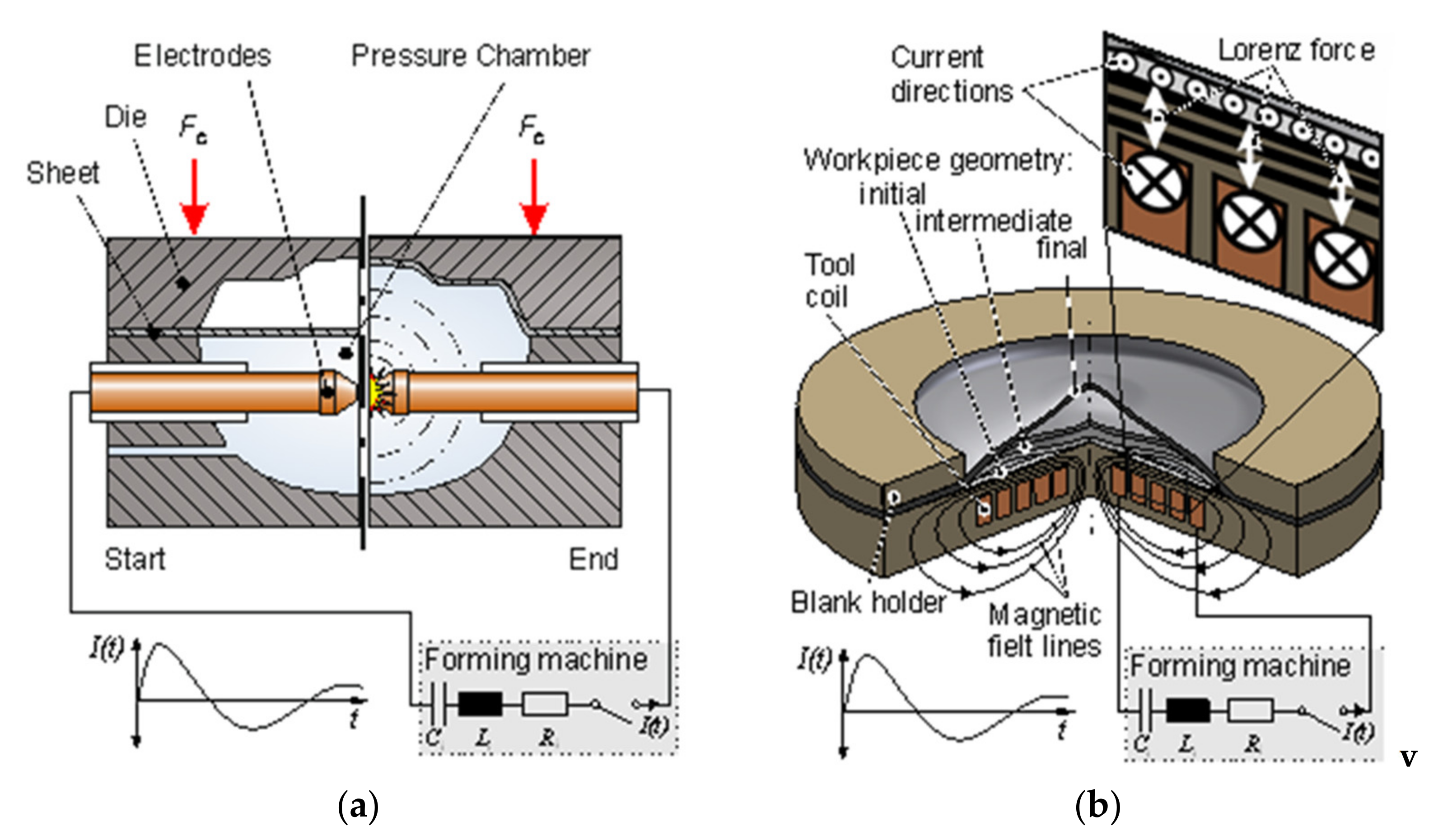
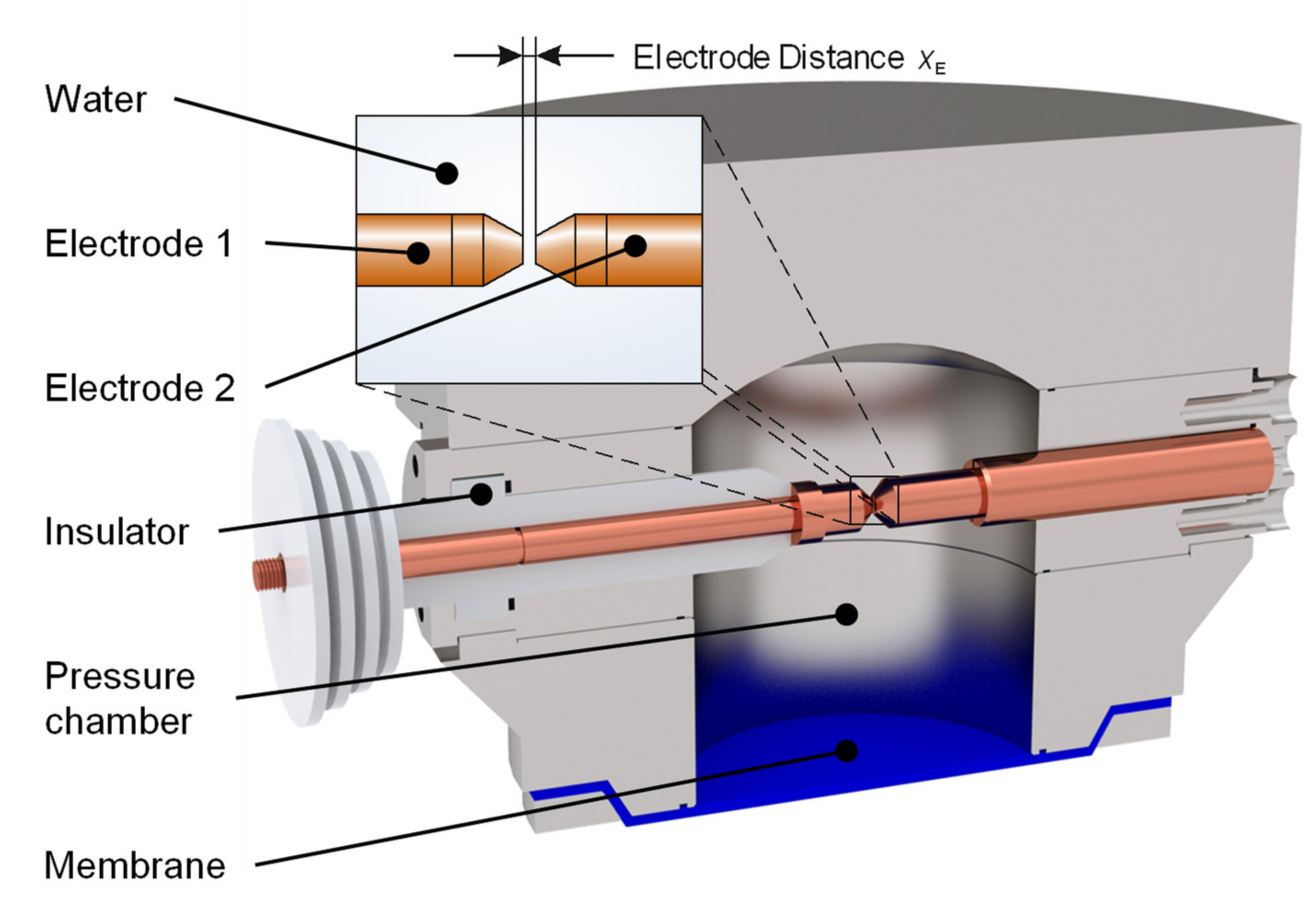
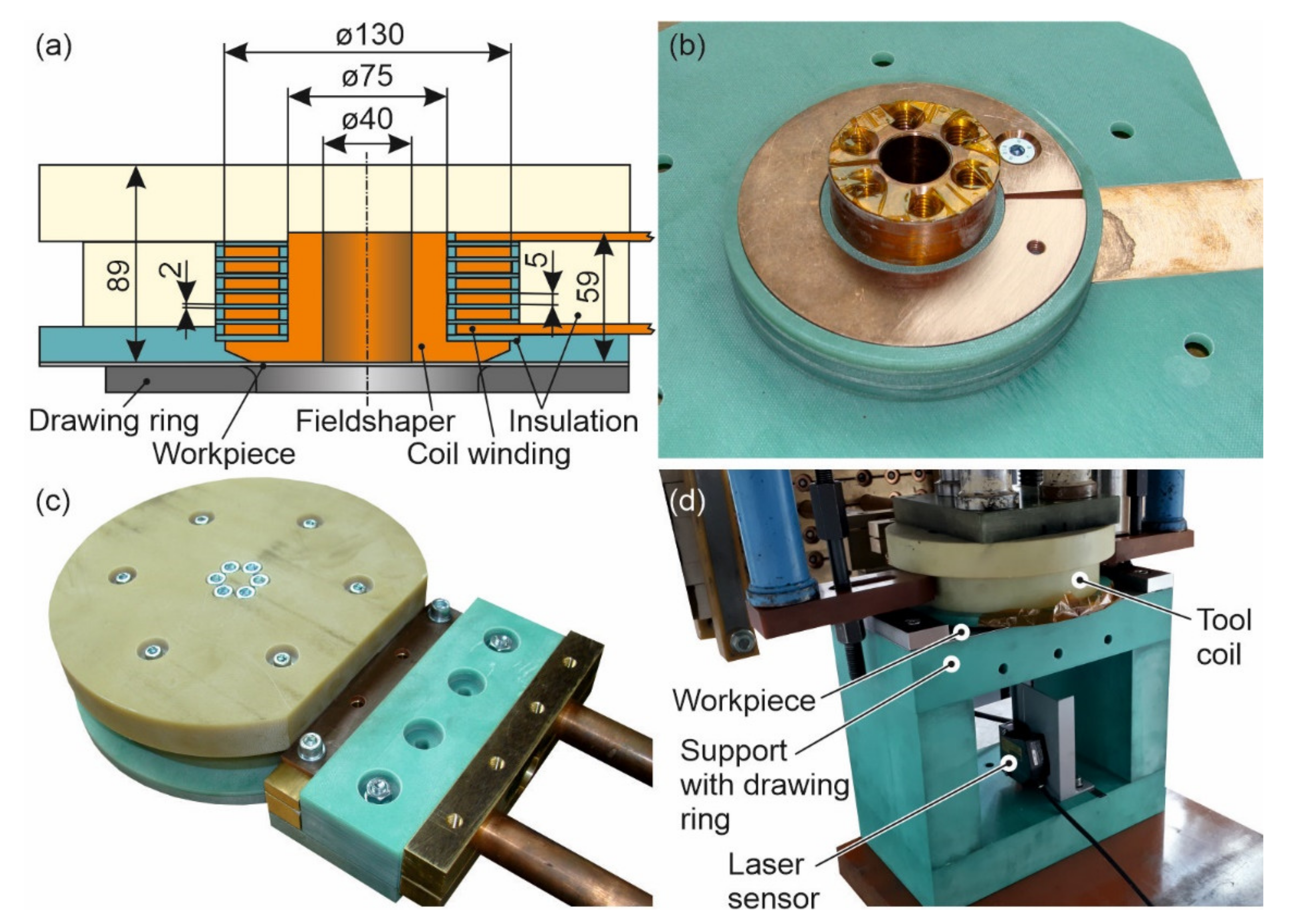

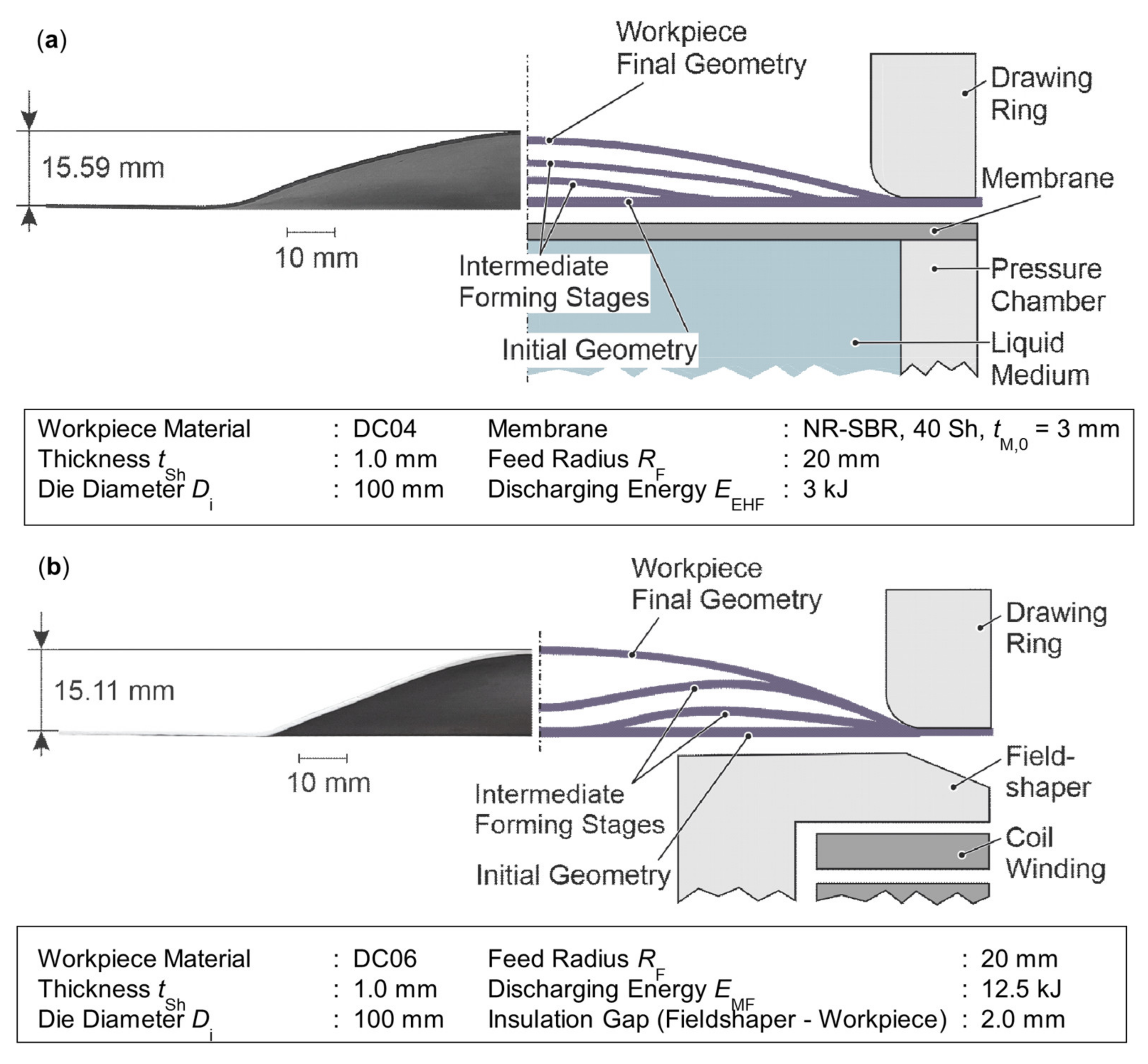
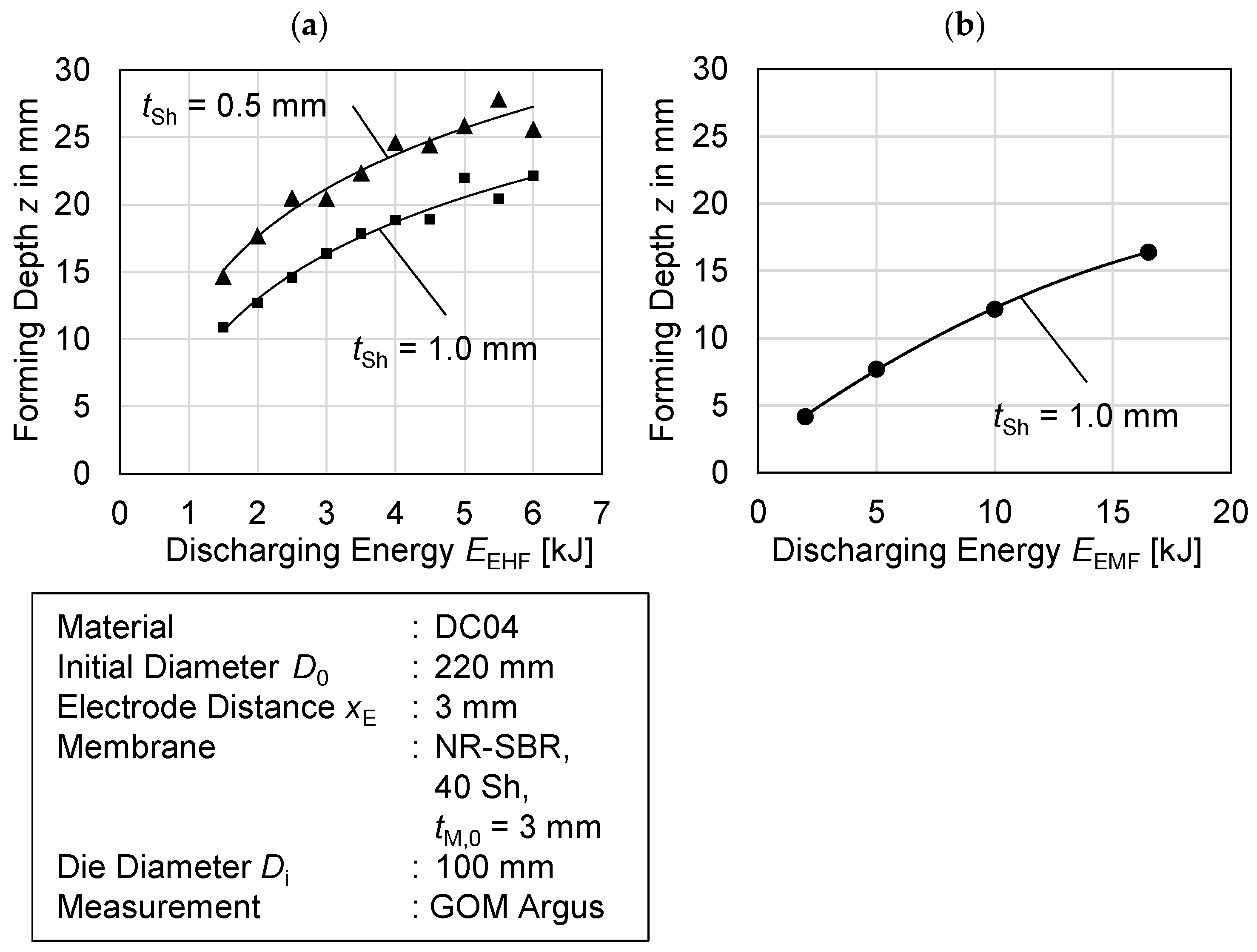
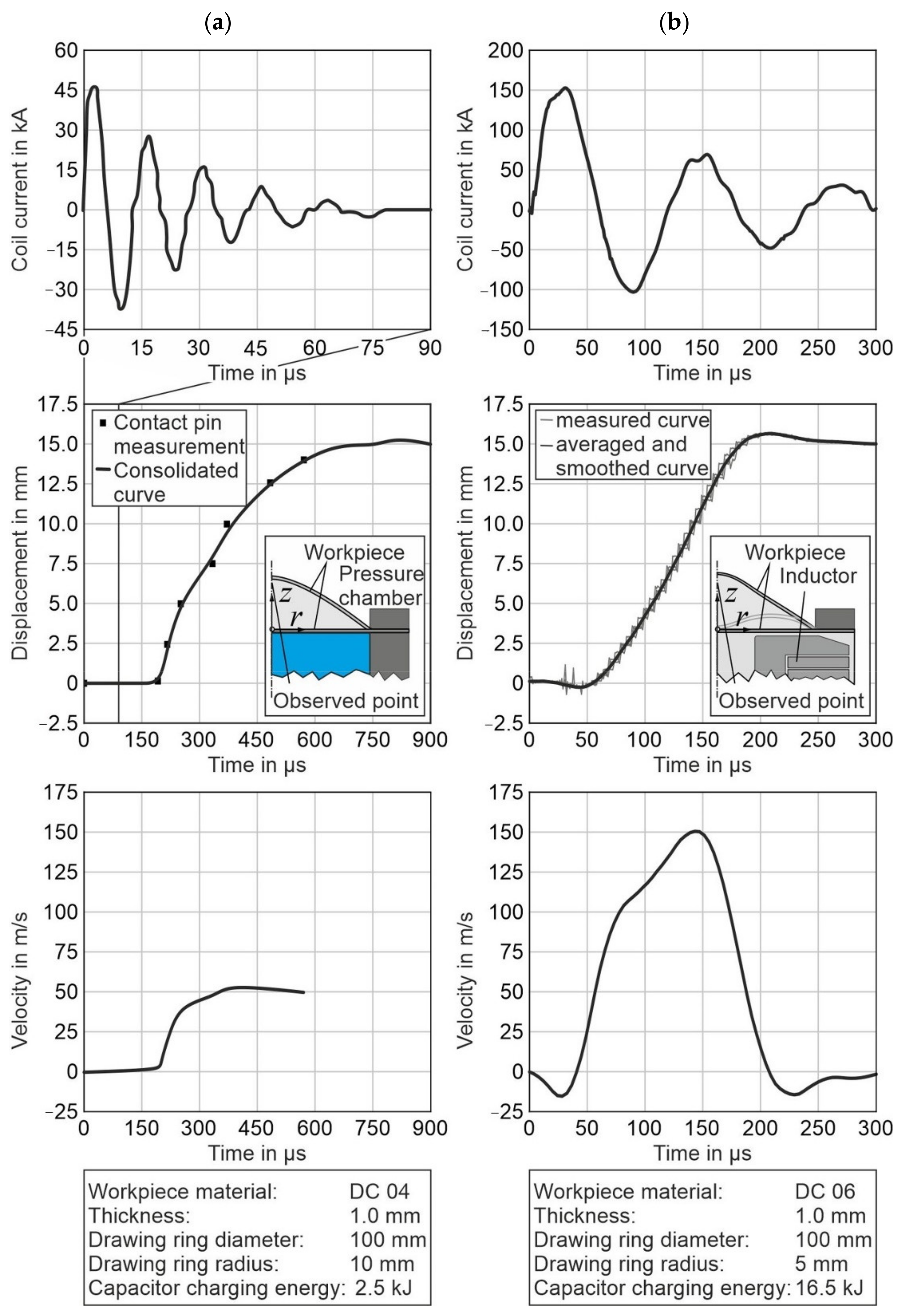



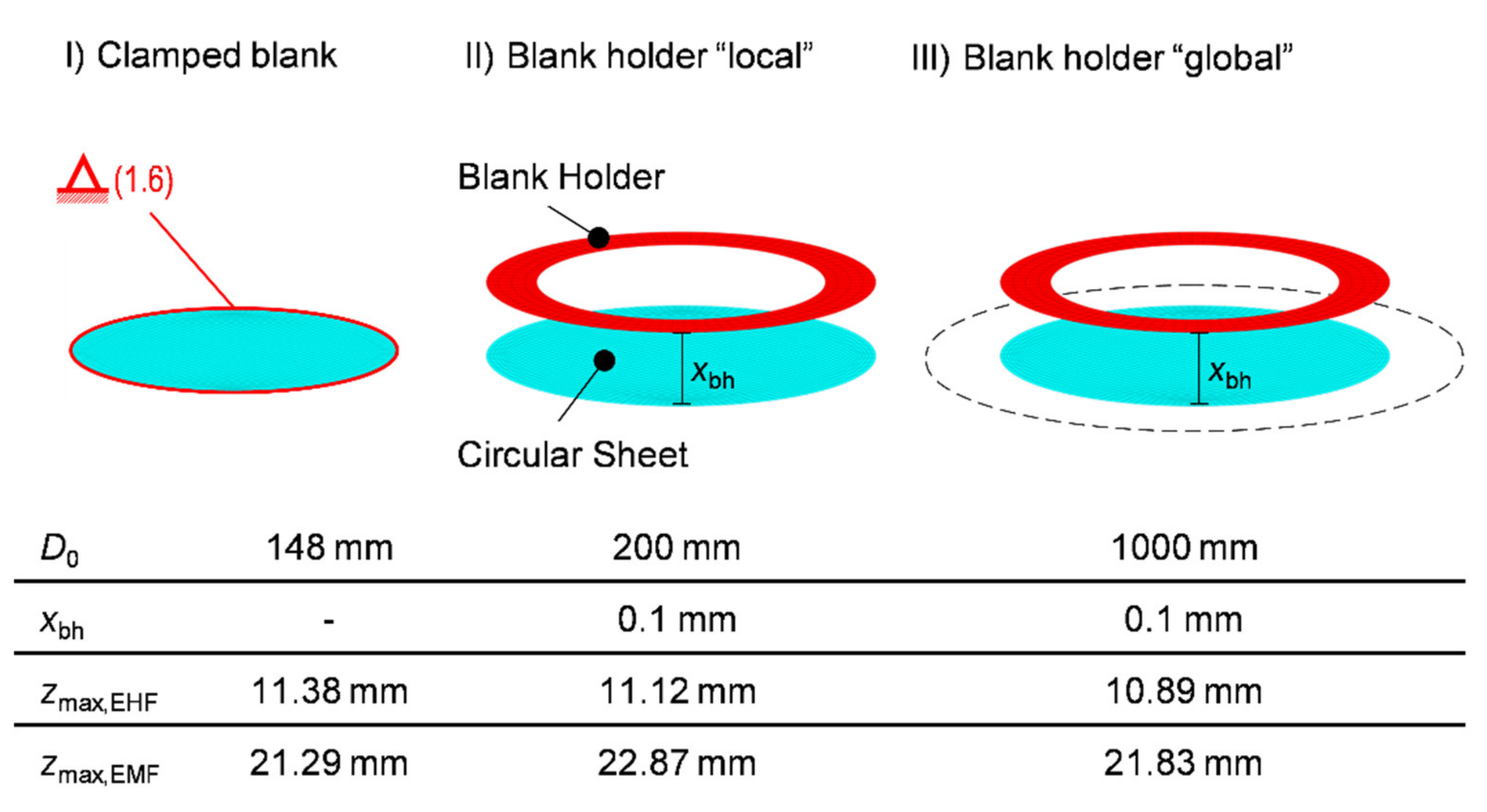
| Max. Capacitor Charging Energy | Max. Capacitor Charging Voltage | Max. Capacitance | Max. Discharge Current 1 | Max. Frequency of the Discharge Current 1 |
|---|---|---|---|---|
| 6 kJ | 20 kV | 30 μF | 160 kA | 100 kHz |
| Max. Capacitor Charging Energy | Max. Capacitor Charging Voltage | Max. Capacitance | Max. Discharge Current 1 | Max. Frequency of the Discharge Current 1 |
|---|---|---|---|---|
| 103 kJ | 25 kV | 320 μF | 2.2 MA | 60 kHz |
Publisher’s Note: MDPI stays neutral with regard to jurisdictional claims in published maps and institutional affiliations. |
© 2022 by the authors. Licensee MDPI, Basel, Switzerland. This article is an open access article distributed under the terms and conditions of the Creative Commons Attribution (CC BY) license (https://creativecommons.org/licenses/by/4.0/).
Share and Cite
Heggemann, T.; Psyk, V.; Oesterwinter, A.; Linnemann, M.; Kräusel, V.; Homberg, W. Comparative Analysis of Electrohydraulic and Electromagnetic Sheet Metal Forming against the Background of the Application as an Incremental Processing Technology. Metals 2022, 12, 660. https://doi.org/10.3390/met12040660
Heggemann T, Psyk V, Oesterwinter A, Linnemann M, Kräusel V, Homberg W. Comparative Analysis of Electrohydraulic and Electromagnetic Sheet Metal Forming against the Background of the Application as an Incremental Processing Technology. Metals. 2022; 12(4):660. https://doi.org/10.3390/met12040660
Chicago/Turabian StyleHeggemann, Thomas, Verena Psyk, Annika Oesterwinter, Maik Linnemann, Verena Kräusel, and Werner Homberg. 2022. "Comparative Analysis of Electrohydraulic and Electromagnetic Sheet Metal Forming against the Background of the Application as an Incremental Processing Technology" Metals 12, no. 4: 660. https://doi.org/10.3390/met12040660







